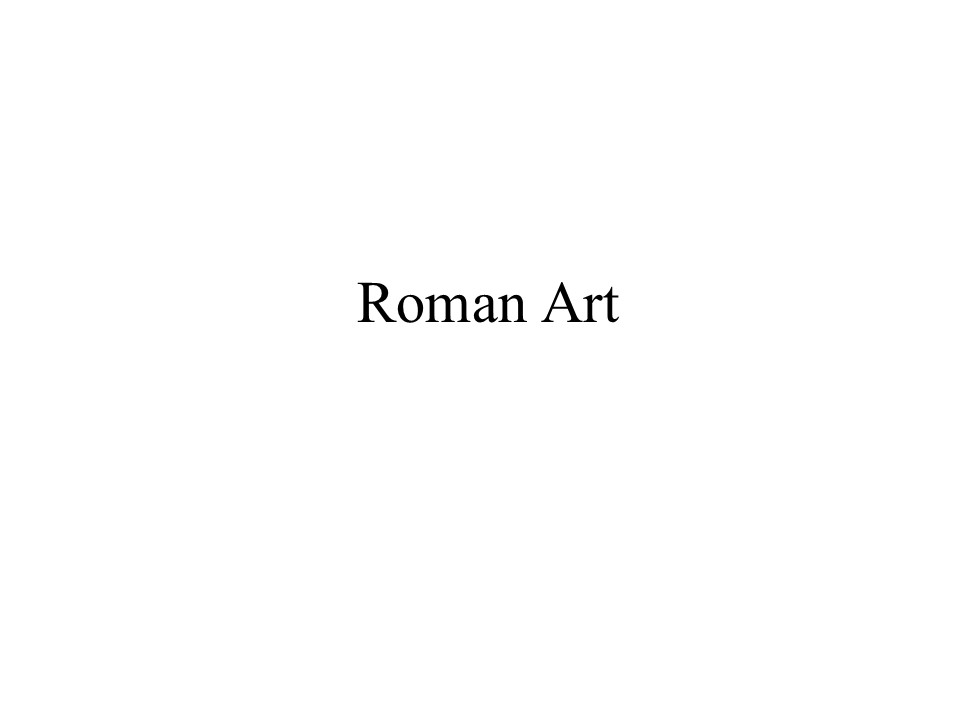Roman Art - PowerPoint PPT Presentation
Title:
Roman Art
Description:
Roman Art Arch of Constantine, 312-315ce Distribution of largesse, detail of arch of Constantine Portrait of Constantine, 315-330ce Basilica Nova, 306-312ce Aula ... – PowerPoint PPT presentation
Number of Views:393
Avg rating:3.0/5.0
Title: Roman Art
1
Roman Art
2
(No Transcript)
3
Roman Chronology 1. Republic (sculpture may
be called Roman Verism)
509BCE-27 BC ends with Julius Caesar 2. Early
Empire (Early Roman Imperial) (Roman Hellenism)
27 BCE-180 CE from Augustus to Marcus
Aurelius 3. Late Empire (Late Roman Imperial)
180BCE-395
CE Constantine Edict of Milan, 313 grants
religious freedom
4
The Rise of the Republic
- Began with overthrow of last Etruscan King
Tarquinius Superbus - Single government ruled for the first time in
history - Within this rule were a vast combination of
people from various cultures, creeds, religions,
tongues. - As Romans gained land and authority, they
employed a legal, administrative and cultural
structure that would last for years to come, and
still seen today.
5
(No Transcript)
6
More info.
- Roman builders and architects developed rational
planning, durable materials, and highly
sophisticated engineering methods - The Romans built a vast and sophisticated network
of roads. Many modern European highways still
follow the lines laid down by the Roman engineers - Wealthy Romans even brought nature in doors by
commissioning artists to paint landscapes on the
interior walls of their homes. - professional artists were generally considered
little more than skilled laborers. - The Romans adopted the Greek gods and heroes as
their own. The Romans assimilated Greek religious
beliefs and practices into a form of state
religion.
7
Early Roman Architecture
- Exposure to Greek art increased as Romans
conquered land beyond Italy (Greece became a
Roman province in 146 BC)
8
Temple of Portunus, Rome, 75bce
9
Sculpture
- Ancestry was held in very high regard, important
for dead family members to have presence. - Portraits were a way of showing patricians
elevated status
10
42. Head of a Roman Patrician, Republican Roman.
c.75-50 BCE marble
Form
Content
Function
Context
Terms
Themes
11
Head of an old man, mid 1st century bce
12
Portrait of Roman general, 75-50 bce
13
http//touritaly.org/pompeii/pompeii-main.htm
14
Brawl in the Pompeii amphitheater, wall painting,
60-79ce
15
39. House of the Vettii. Pompeii, Italy. Imperial
Roman. c. second century BCE rebuilt c.62-79 CE.
Cut stone and fresco. (3 images)
Form
Content
Function
Context
Terms
Themes
House owned by two relatives, Aulus Vettius
Restitutus and Aulus Vettius Conviva. The house
expresses wealth, a new class of wealthy freedmen
moving into Pompeii after the 62 CE
16
(No Transcript)
17
40. Alexander Mosaic from the House of Faun,
Pompeii. Republican Roman. c.100 BCE Mosaic
Form
Content
Function
Context
Terms
Themes
18
Early Roman Empire
19
Propaganda
- Art that is created to influence or promote an
idea to the public
20
Norman Rockwell, Rosie the Riveter
Rockwells famous Rosie the Riveter poster is
shown below, representing the American women who
worked in the munitions and war supplies
factories during World War II. This was a call to
arms for the women of America to become strong
capable females and support the war effort.
21
America is personified as Uncle Sam
22
(No Transcript)
23
43. Augustus of Prima Porta. Imperial Roman.
Early first century CE Marble
Form
Content
Function
Context
Terms
Themes
24
Ara Pacis Augustae, Rome, 13-9bce
25
Female personification from Ara Pacis Augustae
26
Procession of family, Ara Pacis Augustae
27
Pont du gard, Nimes, France, 16bce
28
44. Colosseum (Flavian Amphitheater). Rome,
Italy. Imperial Roman. 70-80 CE Stone and
Concrete. (2 Images)
Form
Content
Function
Context
Terms
Themes
29
(No Transcript)
30
(No Transcript)
31
Portrait of Vespasian, 75-79ce
32
Arch of Titus, Rome, after 81ce
33
Spoils of Jerusalem, panel from Arch of Titus
34
45. Forum of Trajan. Rome, Italy. Apollodorus of
Damascus. Forum and markets 106-112 CE column
complete 113 CE Brick and concrete
(architecture) marble (column. (4 images).
Form
Content
Function
Context
Terms
Themes
35
Column of Trajan, Rome, 112ce
36
Column of TrajanTriumphal monument celebrating
victory in the Dacian Wars (2 campaigns)625
scroll-like FriezeTrajan sculpture originally
on topInterior spiral staircaseLittle
violence mostly bureaucratic efficiency,
propaganda to show pax romana rather than
brutalityContinuous narrative Trajan appears
multiple timesFunerary Held Trajans ashes
37
Arch of Trajan, 114-118ce
38
Portrait of Hadrian, 117-120ce
39
46. Pantheon. Imperial Roman. 118-125 CE
concrete with stone facing (2 images)
Form
Content
Function
Context
Terms
Themes
40
(No Transcript)
41
(No Transcript)
42
(No Transcript)
43
Equestrian statue of Marcus Aurelius, 175ce
44
Portrait of Caracalla, 211-217ce
45
Portrait of Trajan Decius, 249-251ce
46
47. Ludovisi Battle Sarcophagus. Late Imperial
Roman. c. 250 CE
Form
Content
Function
Context
Terms
Themes
47
Sarcophagus of philosopher, 270-280ce
48
Portraits of the 4 tetrarchs, 305ce
49
Arch of Constantine, 312-315ce
50
Distribution of largesse, detail of arch of
Constantine
51
Portrait of Constantine, 315-330ce
52
Basilica Nova, 306-312ce
53
Aula Palatina, interior
54
Aula Palatina, early 4th century ce

